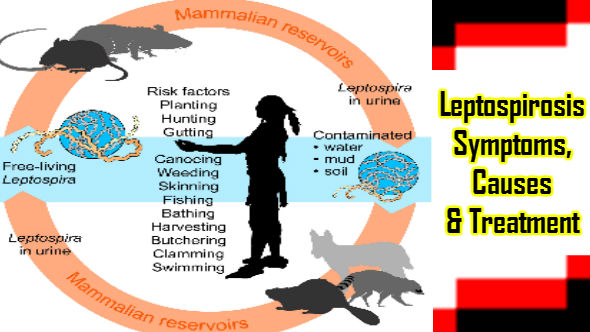Leptospirosis in people is known by a variety of names, reflecting the sources of infection,
e.g., “rice-field fever” and “cane-cutters fever” (transmission from contaminated water) and
“swine herder’s disease” (transmission from contact with infected animals). Leptospirosis
is a disease caused by bacteria (Leptospira interrogans) that produce a wide range of
symptoms that may occur in phases; some patients may develop kidney or liver failure,
respiratory failure, meningitis, or even death. The disease is spread by the urine of
infected animals (many species, both domesticated and wild); the bacteria can survive
in the water and soil for months. The disease is most common in temperate and tropical
climates. The infecting bacteria occur worldwide.

The symptoms of leptospirosis usually develop abruptly seven to 14 days after exposure
to the leptospira bacteria.
However, it is possible for symptoms to develop from between two and 30 days after
exposure.
About 90% of leptospirosis infections only cause mild symptoms, including:
- a high temperature (fever) that is usually between 38 and 40°C (100.4-104°F)
- chills
- sudden headaches
- nausea and vomiting
- loss of appetite
- muscle pain, particularly affecting the muscles in the calves and lower back
- conjunctivitis (irritation and redness of the eyes)
- cough
- a short-lived rash
These symptoms usually resolve within five to seven days. However, in about 10% of
cases people go on to experience more serious symptoms.
Severe leptospirosis
Severe leptospirosis infections are sometimes called Weil’s disease. The symptoms of
a severe infection usually develop one to three days after the more mild symptoms have
passed.
The pattern of symptoms usually falls into one of three groups, depending on which
organs have become infected:
- the liver, kidneys and heart
- the brain
- the lungs
In rare cases, it is possible to experience all three groups of symptoms at the same
time.
Liver, kidney and heart
If these organs are affected, you will probably experience the following symptoms:
- jaundice (yellowing of the skin and the whites of the eyes)
- loss of appetite
- tiredness
- shortness of breath
- swollen ankles, feet or hands
- weight loss
- muscle aches
- nausea
- a noticeable, painful swelling in your liver
- a decrease in the amount of urine that you pass
- chest pain
- rapid and irregular heartbeat
The brain
There are two ways that the brain can be affected:- the outer layer of the brain becomes infected (meningitis)
- the brain tissue becomes infected (encephalitis)
What is the treatment for leptospirosis?
- Although there is controversy about using antibiotics in the first phase of
- leptospirosis, antibiotics are recommended for treatment (penicillin G, ampicillin
- [Omnipen, Polycillin, Principen], amoxicillin [Amoxil, Dispermox (Discontinued),
- Trimox, Moxatag, Larotid], or erythromycin [E-Mycin, Eryc, Ery-Tab, PCE, Pediazole,
- Ilosone]) in patients with phase two or more severe symptoms. Some patients may
- require IV antibiotics and supportive hospital care.For those clinicians who choose
- to treat phase-one patients, the choice of antibiotics includes the above; many
- choose to treat with doxycycline, however.
What is the prognosis of leptospirosis?
- Overall, the prognosis of leptospirosis is good; many become infected and
- spontaneously recover without treatment. However, the prognosis decreases as
- the symptoms increase; people with Weil’s disease may have a prognosis ranging
- from good to poor, depending on their response to treatments. Pregnant women
- who become infected have a high rate of fetal mortality, especially if they acquire
- the disease early in pregnancy.

No comments:
Post a Comment